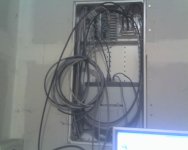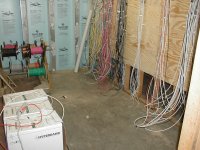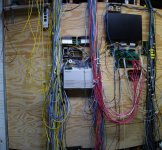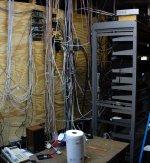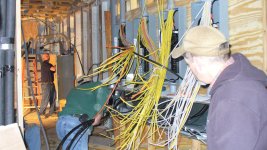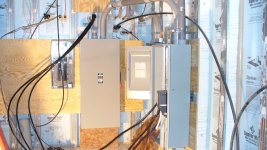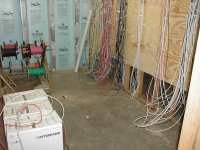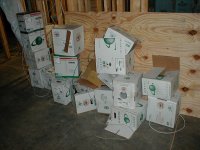coyote: Just a house, but it's just about everything you could ever want to automate. Took 3 of use 3 weeks to pull the wires, new construction. Put a long narrow room in the basement for all the low voltage stuff. It's underneath the TV room on the 1st floor.
The IR repeaters are made by various companies. I used the Dinky Link receiver and the automation system drives the IR LED emitter. There are complete systems out there that take a receiver and drive the IR LEDs. This used to be simple, but the advent of flat panel TVs (both plasma and LCD) and compact florescent lights (CFLs) has muddied the water. You need to get a receiver that is designed to work with these types of TVs. When in doubt, get the plasma compatible (best design, most expensive, about $80 to $130). TV IR remotes use an ultrasonic carrier frequency in the 32 to 50 KHz range. The florescent lights and plasma TVs produce a _lot_ of noise in the 75 KHz and higher range. So the "older" IR receivers that went up to 100 KHz get swamped by all that light noise and don't work.
I've had no problem running the receivers back to the boxes that drive the LEDS on cat5e even though the gauge is smaller than recommended. It's another good reason to run those 3 cat 5e's to TV areas. Many TVs now can connect to an Ethernet line. Then you need a cat-5 for the IR. The cat5 cable should be about $110 per 1K feet, so an extra box of it is your cost to be ready for more than you thought of on day 1. For the component TVs in the bedrooms, I have 4 coaxes (3 for video, one for off air) and 3 cat5e (audio, Ethernet, and IR). Off air system is mix of antenna in attic (with an amplifier) and modulators from the video surveillance cameras.
BTW, the automation system is something I'm working on, not commercially available yet...
About the pix: Some folks like to tie down all the wires into connectors so it looks clean. But then you need to run wires from the connectors to the equipment, and it looks like my pix unless you go tie wrap crazy. So I brought all the wires to the floor and just run them to the equipment. A more normal house needs about a 4' x 4' hunk of plywood for mounting things. Note also that I'm playing with all this stuff, vs. a more static installation, so I take "it works and it's fun" over "it looks neat".
Wireless is great for where you can't have wires. There's a deep thought

. So if you can put in cat5e for Ethernet for your computers do it. I also have a wireless end point for laptops and people who visit (both their laptops and their smart phones). There are two reasons I don't like wireless. One is that when everyone uses it, it tends to have problems and it's hard to diagnose problems. Imagine 3 computer users playing games or watching video with their laptops, the home security system is all wireless, you're talking on a wireless phone connected to the wired phone in your house, you have a new electric meter with wireless, and if you're too close to your neighbors they are doing the same. You really think all those things are going to auto configure and play nice?
The second thing I don't like about wireless is all those batteries.
So if you've got a DSL or cellular router and can run some cat5e to your computer from that, I'd do it. Like lots of stuff, wireless is good in moderation.
If the OP wants to know more about automation pre-wireing, I can go on. Someday (year) I'll have all this documented and start a thread on it. I'm finishing up a new tractor garage, and it has security, phone, video surveillance, and house page system. So this does have _some_ tractor tie-in to it. I hope the OP can run more than just a power conduit to his future shop.
Pete

